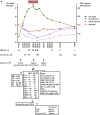Collapsing glomerulopathy in a COVID-19 patient
- PMID: 32471639
- PMCID: PMC7156952
- DOI: 10.1016/j.kint.2020.04.006
Collapsing glomerulopathy in a COVID-19 patient
Figures


Comment in
-
Visualization of putative coronavirus in kidney.Kidney Int. 2020 Jul;98(1):231-232. doi: 10.1016/j.kint.2020.05.004. Epub 2020 May 8. Kidney Int. 2020. PMID: 32437764 Free PMC article. No abstract available.
References
-
- Rosenberg A.Z., Naicker S., Winkler C.A., Kopp J.B. HIV-associated nephropathies: epidemiology, pathology, mechanisms and treatment. Nat Rev Nephrol. 2015;11:150–160. - PubMed
-
- Tomlinson L., Boriskin Y., McPhee I. Acute cytomegalovirus infection complicated by collapsing glomerulopathy. Nephrol Dial Transplant. 2003;18:187–189. - PubMed
Publication types
MeSH terms
LinkOut - more resources
Full Text Sources
Other Literature Sources

